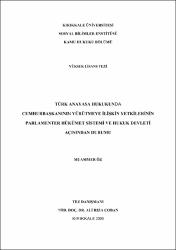| dc.contributor.advisor | Çoban, Ali Rıza | |
| dc.contributor.author | Öz, Muammer | |
| dc.date.accessioned | 2021-01-16T18:58:47Z | |
| dc.date.available | 2021-01-16T18:58:47Z | |
| dc.date.issued | 2009 | |
| dc.identifier.uri | | |
| dc.identifier.uri | https://hdl.handle.net/20.500.12587/15210 | |
| dc.description | YÖK Tez ID: 261318 | en_US |
| dc.description.abstract | 1982 Anayasası, -klasik parlamenter sistem mantığı dışına çıkarak- sürekli tartışılan bir konu olan cumhurbaşkanının yetkilerini önceki anayasalardan farklı olarak arttırmıştır. 2007 yılında 5678 sayılı Kanunla yapılan anayasa değişikliği ile cumhurbaşkanının halk tarafından doğrudan seçilmesi esası getirilmiştir. Böylece yarı-başkanlık sisteminin şekli özellikleri oluşmuştur. Fakat bir ülkenin hükümet sisteminin yarı-başkanlık olarak tanımlanabilmesi için anayasal düzenlemeler tek başına yeterli olmaz. Ayrıca, uygulamada cumhurbaşkanının yetkilerinin kullanım durumunun ve sistem üzerindeki etkisinin de tespit edilmesi gerekmektedir. Fakat henüz halk tarafından seçilen bir cumhurbaşkanı olmadığından bu tespitleri yapmak mümkün olmamıştır.Cumhurbaşkanının geniş yetkileri, bakanlar kurulu ile yetki çatışmasına sebep olmaktadır. Özellikle kararname imzalama ve idari makamlara atama yapılması gibi yetkiler ciddi krizlere neden olmaktadır. 1982 Anayasası, cumhurbaşkanının tek başına yaptığı işlemlere dair yargısal denetim yolunu kapatmıştır. Ayrıca anayasada cumhurbaşkanının hangi yetkilerini tek başına kullanacağı açıkça belirtilmemiştir. Yükseköğretim Kurulu üyelerinin atanması gibi önemli ve tamamen icrai nitelikteki bazı işlemler cumhurbaşkanı tarafından tek başına kullanılmaktadır. Dolayısıyla bunlar yargısal denetim dışında kalmaktadır.Cumhurbaşkanının icrai nitelikteki işlemlerinin karşı imza ile yapılması ve bunların yargısal denetime tabi olması gerekir. Bir anayasa değişikliği ile cumhurbaşkanının hangi yetkilerini tek başına kullanacağının açıkça belirtilmesi bu konudaki tartışmaları önleyecektir. Aynı zamanda cumhurbaşkanının icrai nitelikteki idari işlemlerinin de yargı denetimi kapsamında olduğu anayasada açıkça belirtilmelidir.Anahtar Kelimeler: Cumhurbaşkanı, Parlamenter Sistem, Başkanlık Sistemi, Yarı-Başkanlık Sistemi, Hukuk Devleti. | en_US |
| dc.description.abstract | The Constitution of 1982 increased the authority and powers of the President, which was a permanent subject of controversy in Turkish Constitutional theory, ignoring the mentality of the classical parliamentary system-. In 2007, the Constitutional Amendment Law (Law no: 5678) has changed the election system of the President bringing direct election of president by the public. Following this amendment the visual characteristics of the semi-presidency system has been emerged in Turkish Constitutional system. Nevertheless, pure constitutional regulations are not enough to define government of a state as semi-presidency. To define a system of government as semi-presidency it is necessary to look at the real powers of president in application. But since there has not been a president elected directly by public up to now, there has no possibility to make such observations.The mass powers of the president cause a conflict between the president and the Council of Ministers. Especially, the authorities such as signing governmental decrees and appointments to the administrative positions cause serious crises. The 1982 Constitution bans judicial review of the acts of the president on his or her own capacity. On the other hand, it has not been clearly stated in the Constitution which authorities of the president can be used by President without counter signature. The president, in practice, uses some important powers such as appointment of the members of Higher Education Council and appointment of university rectors which have totally administrative character, without counter signature therefore those act are out of judicial review.The acts of the President which have executive character should be made by countersignature and these should be subject to judicial review. It will prevent the discussions about which powers can be used by the president without counter signature. At the same time, the executive characteristic of the administrative acts of the President, and they are subject to judicial review should clearly be stated in the Constitution.Key Words: President, Parliamentary System, Presidency System, Semi- Presidency System, Rule of State. | en_US |
| dc.language.iso | tur | en_US |
| dc.publisher | Kırıkkale Üniversitesi | en_US |
| dc.rights | info:eu-repo/semantics/openAccess | en_US |
| dc.subject | Hukuk | en_US |
| dc.subject | Law | en_US |
| dc.title | Türk Anayasa Hukukunda cumhurbaşkanının yürütmeye ilişkin yetkilerinin parlamenter hükümet sistemi ve hukuk devleti açısından durumu | en_US |
| dc.title.alternative | The eveluation of the executive powers of the president in terms of parliamentry system and rule of law in Turkish Constitutional Law | en_US |
| dc.type | masterThesis | en_US |
| dc.contributor.department | KKÜ, Sosyal Bilimler Enstitüsü, Kamu Hukuku Anabilim Dalı | en_US |
| dc.identifier.startpage | 1 | en_US |
| dc.identifier.endpage | 131 | en_US |
| dc.relation.publicationcategory | Tez | en_US |
















